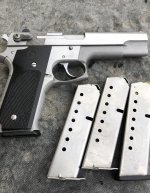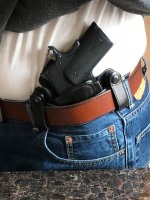I hear "striker fired handguns don't need a safety" a lot, and I hear the much more intelligent "striker fired handguns don't need a safety when they are carried in a holster that covered the trigger" less often but still quite frequently.
I also hear the argument that striker fired handguns require *less* training as the officer/armed citizen doesn't need to be trained to always move the safety lever to the "fire" position when the handgun is drawn and pointed down range at the target.
None of the above statements are entirely true or correct.
You don't have to look very far to find an example of a police officer stressed after a real world shoot who experiences a negligent discharge when they try to reholster their service pistol with their finger still inside the trigger guard. Over the decades since the Glock became a thing in police duty use, duty holsters have evolved to carry Glocks a lot farther out from the leg. Why? Because "Glock Leg" was a way too common occurrence.
Just as often you'll find examples of officers or armed citizens experiencing a negligent discharge when attempting to holster or reholster a striker fired handgun with an object such as the pull cord on a jacket or wad of shirt obstructing the trigger and causing it to fire when the handgun is shoved in the holster. Striker fired and guns are a poor choice for IWB concealed carry, unless:
1) the holster is easily removed from the belt to allow the pistol to be reholstered with the handgun out in front of the shooter where he/she can observe it being reholstered free from any potential obstructions, and then placed back inside the waistband; or
2) the mouth of the holster is larger enough and stiff enough and located in an area where the shooter can fully observe and remove any potential obstructions while the pistol is reholstered.
Ignore 1 & 2 at your peril. Some percentage of people will disagree with both approaches and a percentage of those will shoot themselves in the leg sooner or later.
A trigger guard isn't the solution. It does a good job of preventing objects, including fingers from contacting the trigger while it is in the holster, but can pose a real threat while the handgun is being holstered. It takes a significant degree of situational awareness and training to prevent those kinds of negligent discharges.
In short, the training required to safely carry a striker fired handgun isn't *less*, it's just *different* as the risks, threats and potential errors they pose is different.
Striker fired handguns lack certain safety features found on other types of handguns:
- many of them lack a manual safety;
- all or nearly all of the lack the long and/or fairly heavy trigger pull of a DA or DAO revolver or pistol; and
- all of them lack the tactile feedback of an exposed hammer coming back as the trigger is pulled (although a few models allow the user to prevent the striker from firing by pressing on the back of the frame and interrupting the process of full cocking the striker before it is released).
Those shortcomings *must* be fully addressed in training to prevent a negligent discharge.
——-
The 1911 and other SA only handguns present different training needs - not *more*, just *different*. For example a 1911 or Hi Power shooter should learn to draw the pistol and move the thumb on top of the safety lever as the pistol comes up on target. The shooter then presses the safety down to the fire position and keeps his/her thumb there. It quickly becomes *the* shooting grip and it becomes an automatic response for the thumb to both be there, and to press the safety lever down as the front sight begins to come on target and keep pressing down as part of the normal shooting grip.
Some SA pistols are not very friendly in that regard. For example Sig makes the otherwise excellent P210A, which is a great pistol, except for the safety lever which is way to sharp edged and doesn't encourage the shooter keeping his thumb on it. To be fair it's intended as a target pistol with a target grip more in keeping with what you'd use on an S&W 41. Keep those intended purposes and design compromises in mind when selecting a self defense pistol.
In addition, the 1911 or Hi Power shooter needs to learn to reengage the safety before reholstering. If they also learn to put their thumb over the front of the hammer when reholstering it's a bonus, especially with a 1911 as it also ensures the web of the hand is off the grip safety as well.
Holster wise back in the day it was not uncommon to encounter a 1911 OWB or duty holster that left the trigger exposed. That made it less likely for a stressed officer to put a round into the ground or floor if they tried to reholster with the safety off and finger still inside the trigger guard.
For those who say "a holster that covers the trigger is sufficient and there is no need for a safety on a 1911, Hi Power, etc", I'll suggest you haven't hung around enough at tactical matches where sooner or later an overly excited shooter moves his finger too aggressively and too soon onto the trigger and puts a round in the dirt anywhere from a foot to 10 yards in front of himself before the gun is even close to being on target.
Holsters that have a retention lock that must be deactivated with the trigger finger create similar issues in duty holsters as that learned movement to unlock the retention device with the trigger finger carries over under extreme stress and time pressure to moving the finger onto the trigger vigorously enough to cause the pistol to fire. It's a good idea, it just has unintended and very negative consequences.
——
DA revolvers and pistols are arguably the sweet spot, especially when they have an exposed hammer. The long and usually heavy DA trigger pull gives a fair amount of warning if an obstruction is encountered when reholstering.
Even better, if the thumb is placed over the back of the hammer when reholstering, that hammer coming back is a very obvious tactile indicator the trigger is being pulled.
And of course there is no safety to disengage, or at least a safety isn't needed if present (such as on a CZ75B). It's far more common to find a decocking lever (such as on the CZ75D) that allows the shooter to decock the pistol post shoot, without having to rely on fine motor skills to hold and then gently lower the hammer while pulling the trigger.
Either way, the shooter needs to be trained to either lower the hammer post shoot, or operate the decocking lever before reholstering. Again it's not an issue of more or less training just *different* training.







